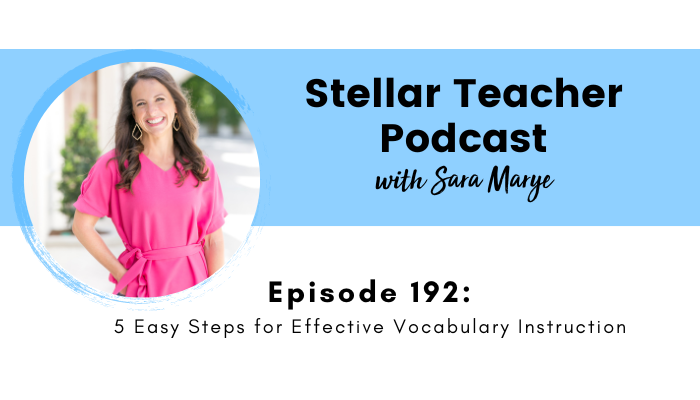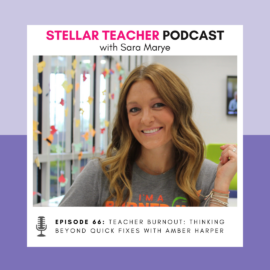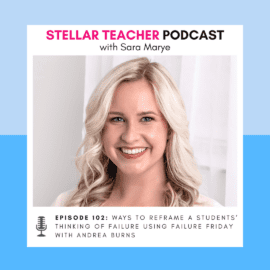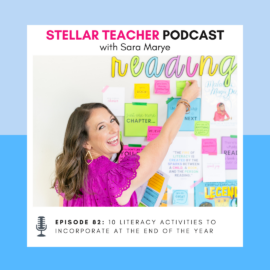
Click play below to hear steps for effective vocabulary instruction:
If I’m being honest, there were a lot of things that I struggled with during my first few years of teaching, but nothing compared to knowing how to teach vocabulary effectively. In my first few years, I implemented several programs, but neither of them seemed to be the key to having my students know the word and use it correctly. Eventually, I figured out what I needed to do for vocabulary to finally stick for my students. So in today’s episode, I’m sharing my five easy steps for effective vocabulary instruction.
On my journey to finding effective vocabulary instruction, I realized I had some common misunderstandings about vocabulary instruction that I needed to overcome. Once I did that, it made teaching vocabulary much easier. The five steps I share are the basics that are needed when explicitly teaching new vocabulary words to students. With each step, I provide an example of how I used it with my students in a way that makes them understand how to use it and not just memorize it. Additionally, there are four more steps I share to further hit home vocabulary instruction.
If most of you take a look at your current vocabulary instruction, I would bet that it’s not working the way you want it to. But by implementing my five easy steps, you will have effective vocabulary instruction that will make vocabulary fun for your students and help them expand their vocabulary knowledge at the same time.
In this episode on effective vocabulary instruction, I share:
- 3 misunderstandings I had about vocabulary instruction and what I should be doing instead
- 5 steps to take when explicitly teaching vocabulary to your students
- Examples of how to implement each step seamlessly and efficiently
- The real goal for students when it comes to learning new vocabulary
- 4 additional steps to help students learn new vocabulary words
Resources:
- Get on the waitlist to join The Stellar Literacy Collective
- Join us for our Free Summer Book Study
- Sign up for my Private Podcast: Confident Writer Systems Series
- Check out the Stellar Literacy Collective Membership
- Check out my Free Literacy Workshop, The Time Crunch Cure: Create a Literacy Block That Fits it All In and Achieves More
- If you’re enjoying this podcast, please leave a review on Apple Podcasts!
Related episodes and blog posts:
- Episode 181, Evidence-Based Strategies for Building Student Vocabulary With Michelle Sullivan
- Episode 40, 10 Fast and Furious Tips to Tackle Vocabulary Instruction
- How to Teach Vocabulary: 10 Tips for Upper Elementary Teachers
- 5 Engaging and Effective Strategies for Teaching Vocabulary
Connect with me:
- Join my newsletter
- Shop my TPT store here
- Instagram: @thestellarteachercompany
- Facebook: The Stellar Teacher Company
More About Stellar Teacher Podcast:
Welcome to the Stellar Teacher Podcast! We believe teaching literacy is a skill. It takes a lot of time, practice, and effort to be good at it. This podcast will show you how to level up your literacy instruction and make a massive impact on your students, all while having a little fun!
Your host, Sara Marye, is a literacy specialist passionate about helping elementary teachers around the world pass on their love of reading to their students. She has over a decade of experience working as a classroom teacher and school administrator. Sara has made it her mission to create high-quality, no-fluff resources and lesson ideas that are both meaningful and engaging for young readers.
Each week, Sara and her guests will share their knowledge, tips, and tricks so that you can feel confident in your ability to transform your students into life-long readers.
Tune in on your favorite podcast platform: Apple, Google, Amazon, Spotify, Castbox, and more! If you’re loving this podcast, please rate, review, and follow!
Podcast (stellar-teacher-podcast): Play in new window | Download
Okay, so have you ever struggled with your vocabulary instruction? I know when I was in the classroom, this is an area that I felt like I was constantly trying to figure out especially as I first started teaching.
I always knew that vocabulary was important. And of course, the more I’ve learned about literacy, the more research has confirmed that, but I couldn’t figure out how to effectively teach it.
And I’ve talked about this before. But when I first started teaching, second grade was my very first teaching position. And I was required to use a basal reader. And I honestly hated the way that we taught vocabulary with that program. Every Monday, we would introduce the list of five to seven story words to our students. It was literally like, here’s your list of words, here are the definitions, you know, I would try to make it cute, but it wasn’t great.
And then every day of the week, they would complete some sort of worksheet or activity related to the words, obviously, we were reading the story, so we would talk about them, then. But then on Friday, they would take the quiz on those vocabulary words. Sometimes they had to match the definition. Sometimes they had to fill in the blank with the words. And honestly, most of my students would ace the quiz. Vocabulary was one of those things that they got excellent grades at. But then my Monday, they would have forgotten the words all together.
And I knew that this method was not working. And even though my students would ace the quiz, I knew that they were not actually expanding their vocabularies. And it really bothered me. But then as I sort of transitioned into my balanced literacy phase, I almost went to the other extreme, and I was no longer teaching individual vocabulary words, because I had such a bad experience with it early on.
But instead, I would look for those teachable moments in our read aloud, where I could find a really rich and exciting vocabulary word, I could talk about it with my students. In that teachable moment, I would highlight the word, I would model using context clues how to figure out the meaning, I would maybe give some other examples of how to use that specific word. And that method, well, it worked, okay for my higher readers.
And honestly, it probably wasn’t that method of instruction that helped my higher readers expand their vocabulary. So it was probably the fact that they were really good at using context clues and already had high vocabulary.
But this method of instruction really wasn’t ideal for my students who needed more explicit instruction. And, you know, since leaving the classroom, I have learned so much about effective vocabulary instruction. And when I think back to my experience teaching vocabulary, especially as a younger teacher, I realized that I had a very narrow view of what vocabulary instruction should be.
And I think there were really like three misunderstandings that I had around vocabulary instruction. First of all, I really thought that vocabulary instruction should be tied to my read aloud, which is true. But that’s not the only time that we can focus on vocabulary. And I was really limiting vocabulary instruction to only when we were reading a chapter book or our basal reader.
You know, so yes, we want to highlight vocabulary during our read aloud. But we don’t want that to be the only time that we are expanding vocabulary. You know, if you think about it, we use words in every subject to communicate all of the time. So vocabulary is one of those things that really can be woven into all parts of your instructional day.
You can do a vocabulary lesson in any subject. You can even do standalone vocabulary lessons that aren’t related to a subject, but have words that are maybe connected to an SEL topic you are studying, or a classroom routine you use or if there’s just a topic that your students are really interested in, teach them some vocabulary related to it.
Another misunderstanding that I had is that I really thought that my vocabulary instruction had to be one type. It’s like all or nothing. I either had to do only explicit and I say explicit with air quotes here because what I was doing was not explicit instruction, but you know, it was either I was here’s your list of words in the definitions, or I’m teaching a teachable moment. And so there wasn’t a good balance of either or.
You know, ultimately, we want both, you know, we want to incorporate explicit vocabulary instruction, which is when we are directly teaching new vocabulary words to our students, and we’re giving them the definition and a bunch of other things to support their understanding of it.
But we also want to incorporate implicit vocabulary instruction, which is when we teach vocabulary through those teachable moments, and we use a word or our students ask us about a word or we notice a word in a read aloud or a video or watching and we talk about the words in the moments, we want both explicit and implicit vocabulary instruction happening in our classroom.
But I think maybe my biggest misunderstanding was that I didn’t recognize how fun vocabulary instruction can be. Words are fun, they are interesting, you know, learning new vocabulary words, when done in a really effective way, can be such an empowering experience for students, students love using big words, they love knowing what words mean.
And I think especially when I first started teaching, I made vocabulary boring and dull. And as a result, my students probably thought it was also boring and dull, because we know that teachers to set the tone for how things go in the classrooms. And honestly, it really took me until the end of my career to figure out how my teaching career I should say, I obviously still have a career in education, but my classroom teaching career to figure out how fun words are.
And even then, since I’ve left the classroom, and really dug into the science of reading research, I’ve learned so much about how to effectively teach vocabulary.
So today, I want to share with you five really easy steps that you can take, anytime that you are explicitly teaching a vocabulary word to your students. You know, maybe it’s a word from your math subject, or a read aloud, maybe it’s a word that you just want to introduce to your students. Whatever it is, these are five things that you can do to really make sure that these words stick with your students.
So the first thing that you always want to make sure you’re doing is using kid friendly definitions. And this sometimes can be difficult, especially for teaching a more complex word, because sometimes it can be hard to take a complex word and make it simple.
So for example, instead of defining the word accumulate with complex terms, you might just say it means to gather up little by little, because that’s something that your students can probably understand.
So in addition to the kid friendly definition, we also want to include some sort of visual aid. And ideally, it would be a real life photograph. And you know how they say a picture’s worth 1000 words. And that is absolutely true. Because when we show our students a real life image, or even if you show them a short video clip that connects to the word, it can really help clarify an abstract concept.
And again, we have to really think about if this is a new word for our students, it’s something they’re unfamiliar with, we’re starting at, you know, ground zero in terms of helping them understand what it means. And if we can show them a picture or a video clip, it might have a concept or, you know, an idea that they’re familiar with. And it’s going to help the word stick, we always talk about that mental Velcro, students have to have some sort of mental Velcro in order for new concepts to sit the same as when we’re introducing vocabulary words.
So if we stick with the word accumulate, as a word you’re introducing to your students, you might show them a picture of snow piling up during a snowstorm. And that would be the visual aid that goes with this word.
In addition to the kid friendly definition and the visual aid, we also can give students related words, you know, again, going back to the mental Velcro, if students have some words that they already know, that are connected to this new word, it is going to help them remember what this word is.
So you can provide them with a list of synonyms, which help them not only understand the meaning of the word, but also again can be another way for you to easily expand their vocabulary and remind them of other words that are related to this. So for the word accumulate, you might want to share synonyms, like collect or build up could be part of your vocabulary discussion.
So the next thing that you want to do is you want to make sure that you’re giving your students some contextual usage. So we don’t ever just want to introduce the word and then move on. We want to make sure students understand when to use that word, how to use that word, how to have it make sense.
So this might be you know, if you’re reading it from the read aloud, you can actually look at the sentence, you can give your students additional sentences that use this word, you could give them scenarios or examples of when they would use this word or when they might see it. And it can be a good idea to give two or three examples. Some examples might resonate better with students and I think just with vocabulary, the more understanding students have, the easier it’s going to be for them to remember this.
So again, if you’re using the word accumulate, you might give them the sentence In winter, the snow accumulates on the ground, creating a thick layer. Now, if you don’t live in a state that has snow, you might want to choose another example. Because that example might not resonate with your students, because they can’t visualize or understand, you know how snow accumulates during the winter.
So then the fifth thing you want to do is to give your students some form of active practice with the word. And, you know, we want students to like the goal is not for them just to know the word, the goal is for them to understand how to use it. And I think oftentimes, we limit our understanding of using the word to asking our students to use it in a sentence.
So when we think of active practice, we want students, yes, to be able to use the word in a sentence, but we also want them to be able to understand sentences that use the word. So we don’t always necessarily have to just ask students write a sentence using this word, which honestly, that task can be and I did this when I was in the classroom, that task can be sometimes challenging, especially if a student is just learning the word for the first time.
So you know, maybe before we have them use the word in the sentence all on their own, we can give them some additional scaffolded active practice that really helps them strengthen their understanding of this word. And there’s a variety of things that you can do for this part of your vocabulary lesson.
One thing that you could do is you could ask your students a yes, no question. So you could maybe ask them, you know, can water accumulate in a puddle when it rains? And the answer to that would be Yeah, you know, when it rains, water can accumulate and puddles helping them understand what the word accumulate means.
You could ask them a true false question. You know, true or false, if you don’t clean your room, toys might accumulate everywhere. True. Again, it’s giving the word in an example. But the students have an engagement piece of these questions.
You could also ask them a question that has choices and they would have to choose, you know, would you want to accumulate a collection of comic books or stickers? And students would have to think about, okay, accumulate means to gather or build up? Which one do I want more of? So asking questions, a variety of ways can be one way to give your students some active practice with the word.
Another option is to give students sentence starters. So that way, they can be sure that they’re using the word correctly, but you’re also making sure that they’re writing their sentence correctly. And you know, it helps them better understand the meaning of the word.
So often, if I would ask my students to use the word in a sentence, you get those very basic words. And sometimes it doesn’t make sense, you know, I accumulate, you know, pets, or I like, accumulate, you know, and so it’s like, okay, clearly, the student doesn’t understand how to use the word and they’re just trying to write a simple sentence to satisfy that part of the worksheet.
So if you can give your students a sentence stem that either uses the word or sets them up to use the word, then that’s going to help them really think about how to use the word in context. So it could be something like the snow started to accumulate quickly covering. And then students would have to think, Okay, what, you know, when snow accumulates, what is it going to cover? Or it could be in fourth grade, you’ll accumulate knowledge about and then students think about, okay, in fourth grade, what am I going to learn knowledge about.
So giving them a sentence starter with the word can be another way to get them to practice using the word without forcing them to write a sentence on their own, which sometimes can be really difficult for students to do.
So those five things I just shared are really the basics. And anytime we’re introducing words to our students, we want to make sure that we have, you know, all of those elements included, because that’s really gonna help vocabulary words stick. But if you want to get real fancy, and add in some additional word study strategies, there’s obviously more that you could do.
And I’m going to share four other things that can be really, really helpful when you are introducing words as well. So one thing obviously, this is also very important to do in upper elementary, but to analyze the word structure, and that means to help your students be able to identify and understand the parts of the word. So we want students to be able to recognize suffixes, prefixes, roots, this can both help them decode the word but also understand the meaning.
For example, let’s say you’re introducing the word unbelievable to your students. So, you would show that word to your students and highlight that this word has the prefix un which means not. It has believe which is related to the word belief which means to have faith or confidence in something and then it has the suffix able which means capable of and so if we put all of that together, unbelievable means not having confidence in something or unable to be believed. So you can always analyze the word structure identify suffixes, roots, prefixes, so important for students, especially in upper elementary.
Other things that you can do are to break the word down into syllables and identify the syllable types. If you have students who are struggling with decoding longer words, this can be really helpful for them because it helps them understand, you know how to separate words, how to identify the different syllable types.
You can also spend time practicing the pronunciation of the word. You know, sometimes these longer words are hard for students to pronunciate. So you can model what that looks like, practice it with your students have them repeat the pronunciation to you, you know, good pronunciation is going to build students competence, and really help them understand how to read the word the next time they see it. And, you know, just keep it as part of their memory as well.
And then you want to pay attention to other things. So, you know, this wouldn’t necessarily be something that you want to do with every word. But look for things like Do you have the opportunity to explore words that have multiple meanings? Or do you have the opportunity to discuss the shades of meaning with words, you know, and shades of meaning simply means that there is a slight difference between the meaning like words like glad and thrilled have a similar meaning. But you know, when you use them in context, there is a slight difference and variation.
So paying attention for sort of those nuances and really understanding if there is words that could be used within the shades of meaning, or words that have multiple meanings, point those out to your students as well.
So lots of extra things that you can add on kind of in addition to those five core steps that you want to take. So as you can see, from really everything that I shared vocabulary can be really fun and engaging for students. But also, none of this needs to take up a ton of time. You know, you can do these things in a few minutes throughout the day before you read at the beginning of a lesson.
And also, I think keep in mind, your instruction doesn’t need to be a one size fits all approach for every single word. You know, obviously, we want to make sure that the words we teach do include these five things, kid friendly definitions, visual aids, connections to other words, contextual usage and active practice. But there are so many different ways that you can enhance your vocabulary instruction, make it fun for students add in additional things. So don’t feel like every time you introduce a word, it needs to be exactly the same, but do include those five things that I just listed.
So if you have not been introducing vocabulary words, this way, this past school year, start now. I know that we are in the final stretch of the school year, but test this structure out with your current students, you know, they’re still going to benefit from effective vocabulary instruction the last month or two of the school year. And it also is going to get you in the habit of teaching vocabulary this way.
I always encourage teachers, the end of the year is the perfect time for you to start to think about what is it that you really want to change and improve for next year. And then start practicing some of those things now with your current group of students, because it’s going to make it much more likely for you to you know, put those things in place for the entire year next year.
So, as always, thank you so much for tuning in. I hope you got a lot out of this episode. Have a wonderful week, and I will see you next Monday.








Leave a Comment
You must be logged in to post a comment.